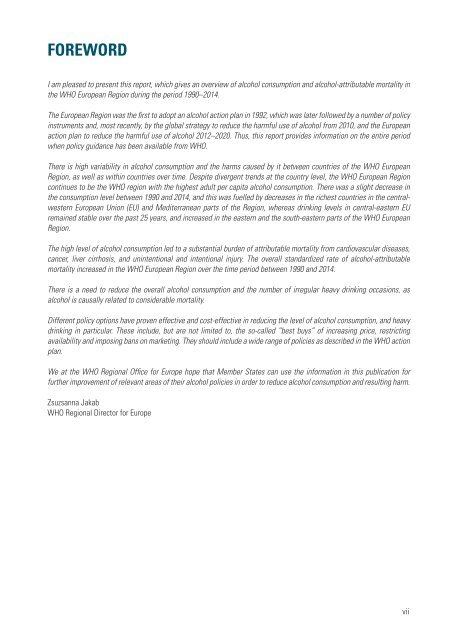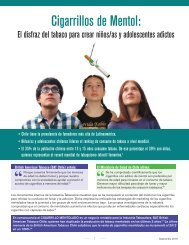Public health successes and missed opportunities
Public-health-successes-and-missed-opportunities-alcohol-mortality-19902014
Public-health-successes-and-missed-opportunities-alcohol-mortality-19902014
Create successful ePaper yourself
Turn your PDF publications into a flip-book with our unique Google optimized e-Paper software.
Foreword<br />
I am pleased to present this report, which gives an overview of alcohol consumption <strong>and</strong> alcohol-attributable mortality in<br />
the WHO European Region during the period 1990–2014.<br />
The European Region was the first to adopt an alcohol action plan in 1992, which was later followed by a number of policy<br />
instruments <strong>and</strong>, most recently, by the global strategy to reduce the harmful use of alcohol from 2010, <strong>and</strong> the European<br />
action plan to reduce the harmful use of alcohol 2012–2020. Thus, this report provides information on the entire period<br />
when policy guidance has been available from WHO.<br />
There is high variability in alcohol consumption <strong>and</strong> the harms caused by it between countries of the WHO European<br />
Region, as well as within countries over time. Despite divergent trends at the country level, the WHO European Region<br />
continues to be the WHO region with the highest adult per capita alcohol consumption. There was a slight decrease in<br />
the consumption level between 1990 <strong>and</strong> 2014, <strong>and</strong> this was fuelled by decreases in the richest countries in the centralwestern<br />
European Union (EU) <strong>and</strong> Mediterranean parts of the Region, whereas drinking levels in central-eastern EU<br />
remained stable over the past 25 years, <strong>and</strong> increased in the eastern <strong>and</strong> the south-eastern parts of the WHO European<br />
Region.<br />
The high level of alcohol consumption led to a substantial burden of attributable mortality from cardiovascular diseases,<br />
cancer, liver cirrhosis, <strong>and</strong> unintentional <strong>and</strong> intentional injury. The overall st<strong>and</strong>ardized rate of alcohol-attributable<br />
mortality increased in the WHO European Region over the time period between 1990 <strong>and</strong> 2014.<br />
There is a need to reduce the overall alcohol consumption <strong>and</strong> the number of irregular heavy drinking occasions, as<br />
alcohol is causally related to considerable mortality.<br />
Different policy options have proven effective <strong>and</strong> cost-effective in reducing the level of alcohol consumption, <strong>and</strong> heavy<br />
drinking in particular. These include, but are not limited to, the so-called “best buys” of increasing price, restricting<br />
availability <strong>and</strong> imposing bans on marketing. They should include a wide range of policies as described in the WHO action<br />
plan.<br />
We at the WHO Regional Office for Europe hope that Member States can use the information in this publication for<br />
further improvement of relevant areas of their alcohol policies in order to reduce alcohol consumption <strong>and</strong> resulting harm.<br />
Zsuzsanna Jakab<br />
WHO Regional Director for Europe<br />
vii




